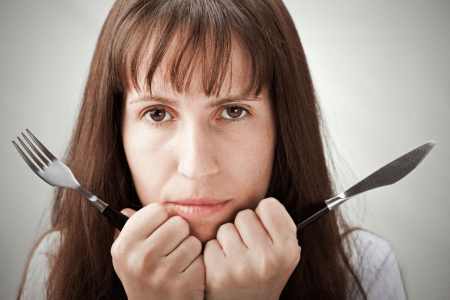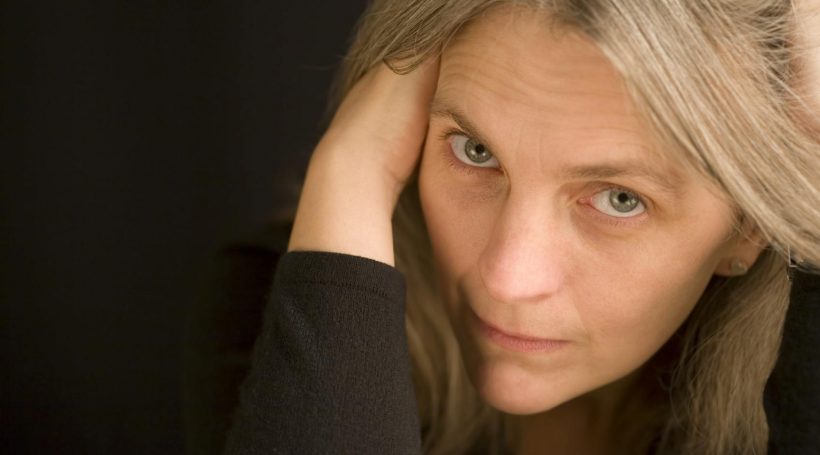Michelle Smith, 43, never sat down to a meal. The wife and mother of two made every dish on the table, but always managed to slip into the kitchen for clean-up duty when the forks hit the food. Her family thought she was busy. But no, for all of her adult life, Smith was bulimic.
Smith is in a growing group. Eating disorders, once thought for young girls only, are ravaging more and more women in their 30s, 40s, 50s and 60s. Whether the conditions are going undetected for decades or they are struggling with relapses, the shift is presenting a new set of challenges for the medical community and the women’s families.
Smith had been purging since she was 21. She was diagnosed at 34, but that didn’t end her battle. In fact, she still struggles with her disease and regularly seeks out professional help to deal with it.
“I had it pretty well-hidden. No one ever said anything, even through my pregnancies. They thought it was morning sickness,” says Smith, a Berlin resident.
Smith purged in private, away from her husband, Richard, and her children. When she came in contact with food, it was a morsel of bread or a pizza crust. The family rarely, if ever, saw her eat.
“I would have breakfast, then purge it. I wouldn’t eat lunch and then not have dinner. I’d have a snack before bed. Then I’d purge that. That was a typical day,” says Smith. “Whatever I ate, I purged. Up to three, four times day. I’d have no dinner and go to bed.”
The facade fell away when she took a blood test at the urging of a confidant’s son, who happened to be a doctor. The test revealed Smith had dangerously low potassium. Kidney failure or cardiac arrest were literally a heartbeat away.
“He told me if I didn’t get help, I was going to die,” says Smith. “I had two young children. They were 8 and 10. I didn’t want to leave them to get treatment, but my husband kept saying, ‘You will leave them one way or another.’”
Smith had to face the fact she would become a statistic if she did not get help. She was placed in an in-patient program at The Renfrew Center, which specializes in the treatment of eating disorders, in 2003 and again in 2007, where she was monitored closely. Now Smith makes weekly trips to the therapist she began seeing a decade ago, as well as bi-weekly visits with a nutritionist and a psychologist.
“I was very resistant to the program. When I did go to Renfrew, and my husband and my friend left, I begged them to take me home. But I stayed. Eight weeks,” says Smith, whose official diagnosis is bulimic with a trauma background. “Being diagnosed, I was angry. I didn’t want anyone to know. I thought I’d done a good job of hiding it.”
 The signs of an eating disorder may be visually apparent in adults, but the conversation about what is happening may never occur. The awkward silences may stem from how eating disorders, in general and regardless of age, are approached, says Lori Feldman-Winter, MD, head of adolescent medicine at Cooper University Health Care.
The signs of an eating disorder may be visually apparent in adults, but the conversation about what is happening may never occur. The awkward silences may stem from how eating disorders, in general and regardless of age, are approached, says Lori Feldman-Winter, MD, head of adolescent medicine at Cooper University Health Care.
According to a survey conducted by Renfrew, 23.5 percent of its overall patients are older than age 35. Anorexia and bulimia have been well known in the public’s mind for decades, but binge eating is becoming just as prominent. Emaciation and restrictive eating characterize anorexia, while bulimia has symptoms of uncontrolled eating followed by purging, fasting or intense exercise. Binge eating has the out-of-control aspect of bulimia, but lacks the purging. Rather than malnourished, binge eaters frequently are obese.
“The problem with eating disorders is there is definitely a stigma and a lot of secrecy. It is difficult to broach,” says Feldman-Winter. “People look for other explanations when there are issues related to weight, whether it is going in either direction. It’s a condition that is under-recognized and under-diagnosed. People can live a long time with a disorder without a frank discussion.”
That is, if they live. According to The American Journal of Psychiatry, the mortality rates for anorexics is 4 percent, 3.9 percent for bulimics and 5.2 percent for non-specified eating disorders. The National Association of Anorexia Nervosa and Associated Disorders determined 18 to 20 percent of anorexics will be dead after 20 years of first developing the disease.
“The patients I know who have died have been adults. People we’ve seen critically ill with anorexia were between their 40s and mid-50s, but it was after a long history. Whatever the run, it’s exacerbated by the eating disorder,” says Michael Pertschuk, MD, a psychiatrist and clinical director at the Eating Disorders Treatment Center in Marlton.
Smith’s physical condition was the catalyst that provoked her first steps toward recovery. Many times, women are driven to find help by the ongoing mental war and the potential of leaving a legacy of the disease to their children. Yet they are adults and, with each passing day, it becomes more difficult for outsiders to prod them to get treatment.
“Women become burned out from this. Many have kids at the age when they developed their eating disorder. They do not want to pass it along,” says Holly Grishkat, PhD, a clinical psychologist who is Renfrew’s assistant regional vice president of clinical operations.
Grishkat, who created Renfrew’s Thirty-Something and Beyond program in 2004 for its adult patients, finds the disease does not spontaneously appear in older women. If it does, she says, it is very rare. The most likely scenario is a relapse or an ongoing problem that was never treated in the first place. Either way, the disease likely became rooted in the younger self and gained steam as a way to deal with life’s tribulations, she says.
“Control is an issue for all, a lot more for adults in transition,” says Grishkat. “If you are suing for divorce, there is little control. A person can look at their life and see what they can control. What you can control is what goes in your body. It’s a way to cope.
“It has a lot to do with loss – divorce, loss of parents, there are the losses in physical appearance,” says Grishkat.
Pertschuk likens the road to relapse the same as anyone with a coping mechanism – and the reason why a disorder doesn’t emerge out of the blue as easily.
“If you never smoked, what kind of stresses would make you want to pick up a cigarette? It doesn’t matter the stressor, but if you smoked 20 years before, there is that vulnerability to go back to it,” he says. “If as a teen you got caught up in binging and purging, it’s still a vulnerability. It can reemerge.”
Once the wound reopens, the patient can find that the needs they had at 16 are very different from the ones they have at 50. Having a chronic condition for five years is vastly different – and takes a different toll on the body and mind – than having it for 35 years. In the Thirty-Something and Beyond program, not only was bodily health a factor in its design, so was the mental state of the adult patient.
“The older women and the younger women were very different. The older women may have osteoporosis from their disease, gastrointestinal problems or arthritis,” says Grishkat. “The exercise program is tailored to them, as is the nutrition group, for the same reasons. The relationship group is too, because we are dealing with divorce or caring for older parents.”
When Smith attended group sessions with younger women she had a whirlwind of emotions that took away from her own healing, she says. If it wasn’t her maternal instincts kicking in, it was her feelings of embarrassment.
“I felt stupid with the young girls. I felt very old. I wanted to help them. There were the same problems, but on different levels,” says Smith. “The Thirty-Something group connected on a different level. We didn’t have to be caretakers to the young girls.”
There may also be the feeling that since the women were the adults in the room, they must be in charge and be comforting. It was a damaging dynamic, says Grishkat.
“When the older and younger women were together, the older women felt shame, they felt they should be role models, so they didn’t take part,” says Grishkat.
Constantly being the adult, even when at their worst, could be a factor in why women do not get help as often as teens. With young girls, there is a parent or a teacher or a Scout leader looking over their shoulder. There is someone older and wiser, who is possibly on the lookout for this type of condition, who can take charge of the situation and take that person to the hospital. With adults, it is all autonomy, all the time.
“Some of the sickest patients I’ve seen have been older. If you are 15 and living with your parents, they see you wasting away. They will push you to see a doctor. If you are an adult, you may be living alone and there may not be an authority to push you,” says Pertchsuk. “There isn’t some authority figure to say, ‘I’m taking you to the hospital.’”
When the weight loss or the frequent bathroom trips add up to an eating disorder, there may be still a reluctance to say anything for fear of getting too personal or too pushy.
“People assume, ‘She’s 45. I’m sure someone has addressed it’ or ‘It’s not that,’” says Cooper’s Feldman-Winter. “But as an adult, it can go unrecognized. There are more adults walking around with eating disorders as chronic diseases. They are never identified or treated. They are able to function, hold a job and take care of their families. Whatever happens, they end up modeling destructive eating behaviors. It becomes a family cycle. It may become more severe in their children.”
Smith is committed to becoming healthy. She is rebuilding friendships she pulled away from during her darkest periods. She is faithful in keeping her meetings with Grishkat. She talks with her children about the times she has gone away, and she deals with the residual feelings it has left in her entire family.
“I asked my daughter if she was angry. She said, ‘Yes,’” says Smith. “My son wasn’t angry, but scared that I’d go away again. It’s still with them. It makes me feel…how could I have done it differently?”
Smith’s daughter is approaching the same age that Smith began her bulimia. Smith is confident her daughter, who is attending college out of state, will not suffer the same fate. By helping herself, Smith feels she has broken the cycle.
“My daughter is a very independent girl. I always told her she is beautiful inside and out,” she says. “I believe she believes that.”














